百度网站置顶怎么做兰州seo实战优化
找往期文章包括但不限于本期文章中不懂的知识点:
个人主页:我要学编程(ಥ_ಥ)-CSDN博客
所属专栏:数据结构(Java版)
顺序表的学习,点我
上面这篇博文是关于顺序表的基础知识,以及顺序表的实现。
目录
手动实现顺序表的源码:
分析Java 8 的 ArrayList 的源码
字段:
构造方法:
ArrayList本身的扩容机制和分配内存机制
ArrayList常见操作
ArrayList的遍历
普通for循环遍历
for-each遍历
toString方法遍历
迭代器遍历
手动实现顺序表的源码:
下面是Java版的顺序表源码:
public class MyArraylist {public int[] elem;public int usedSize;//0//默认容量private static final int DEFAULT_SIZE = 10;public MyArraylist() {this.elem = new int[DEFAULT_SIZE];}/*** 打印顺序表:* 根据usedSize判断即可*/public void display() {for (int i = 0; i < this.usedSize; i++) {System.out.print(this.elem[i]+" ");}System.out.println();}// 新增元素,默认在数组最后新增public void add(int data) {// 增加元素之前得先判断数组是否已满if (isFull()) {expansion();}// 尾插数据不需要判断 pos 位置是否合法elem[this.usedSize++] = data;}// 扩容private void expansion() {// 原来数组的2倍扩容this.elem = Arrays.copyOf(this.elem, 2 * this.elem.length);}/*** 判断当前的顺序表是不是满的!* @return true:满 false代表空*/public boolean isFull() {// 判断这个数组的有效元素个数是否等于数组的长度return this.usedSize == this.elem.length;}private boolean checkPosInAdd(int pos) {if (pos < 0 || pos > this.usedSize) {return false;}return true;//合法}// 在 pos 位置新增元素public void add(int pos, int data) throws PosofAddException{if (!checkPosInAdd(pos)) {throw new PosofAddException("add(int pos, int data) " +"pos位置不合法");}// 判断是否为尾插if (pos == this.usedSize) {add(data);}else {// 开始移除元素(从后往前移除)for (int i = this.usedSize; i > pos; i--) {this.elem[i] = this.elem[i-1];}// 开始插入数据this.elem[pos] = data;this.usedSize++;}}// 判定是否包含某个元素public boolean contains(int toFind) {// 先判断这个数组是否有元素if (isEmpty()) {return false;}for (int i = 0; i < this.usedSize; i++) {if (this.elem[i] == toFind) {return true;}}return false;}// 查找某个元素对应的位置public int indexOf(int toFind) {for (int i = 0; i < this.usedSize; i++) {if (this.elem[i] == toFind) {return i;}}return -1;}// 获取 pos 位置的元素public int get(int pos) throws PosofGetException{if (pos < 0 || pos > this.usedSize) {throw new PosofGetException("get(int pos)" +"pos位置不合法");}return this.elem[pos];}private boolean isEmpty() {// 有效数据个数为0,就是为空return this.usedSize == 0;}// 给 pos 位置的元素设为【更新为】 valuepublic void set(int pos, int value) throws PosofSetException{// 先得判断这个 pos 位置是否合法if (pos < 0 || pos >= this.usedSize) {throw new PosofSetException("set(int pos, int value)" +"要修改的位置不合法");}this.elem[pos] = value;}/*** 删除第一次出现的关键字key* @param key*/public void remove(int key) throws PosofRemoveException{int pos = indexOf(key); // 下标if (pos < 0) {throw new PosofRemoveException("remove(int key)" +"没有您要删除的数据");}for (int i = pos; i < this.usedSize - 1; i++) {// 后一个位置往前覆盖this.elem[i] = this.elem[i+1];}this.usedSize--;}// 获取顺序表长度public int size() {return this.usedSize;}// 清空顺序表public void clear() {// 由于存放的是基本数据类型,直接清空即可this.usedSize = 0;// 如果存放的是引用数据类型就得通过for循环遍历把数组的内容置为null// 注意:如果直接把数组置为null的话,就会存在安全问题,而且源码也是遍历的方式}
}
异常:
PosofAddException:
public class PosofAddException extends RuntimeException{public PosofAddException() {}public PosofAddException(String msg) {super(msg);}
}
PosofGetException:
public class PosofGetException extends RuntimeException{public PosofGetException() {}public PosofGetException(String msg) {super(msg);}
}PosofSetException:
public class PosofSetException extends RuntimeException{public PosofSetException() {}public PosofSetException(String msg) {super(msg);}
}
PosofRemoveException:
public class PosofRemoveException extends RuntimeException{public PosofRemoveException() {}public PosofRemoveException(String msg) {super(msg);}
}
分析Java 8 的 ArrayList 的源码
实现了咱们自己写的顺序表了之后,就该来看Java本身的源码是怎么写的以及与我们的有什么不同?(注意:由于Java 17封装性太强,不好观看源码,因此下面的源码来自Java 8。)
字段:
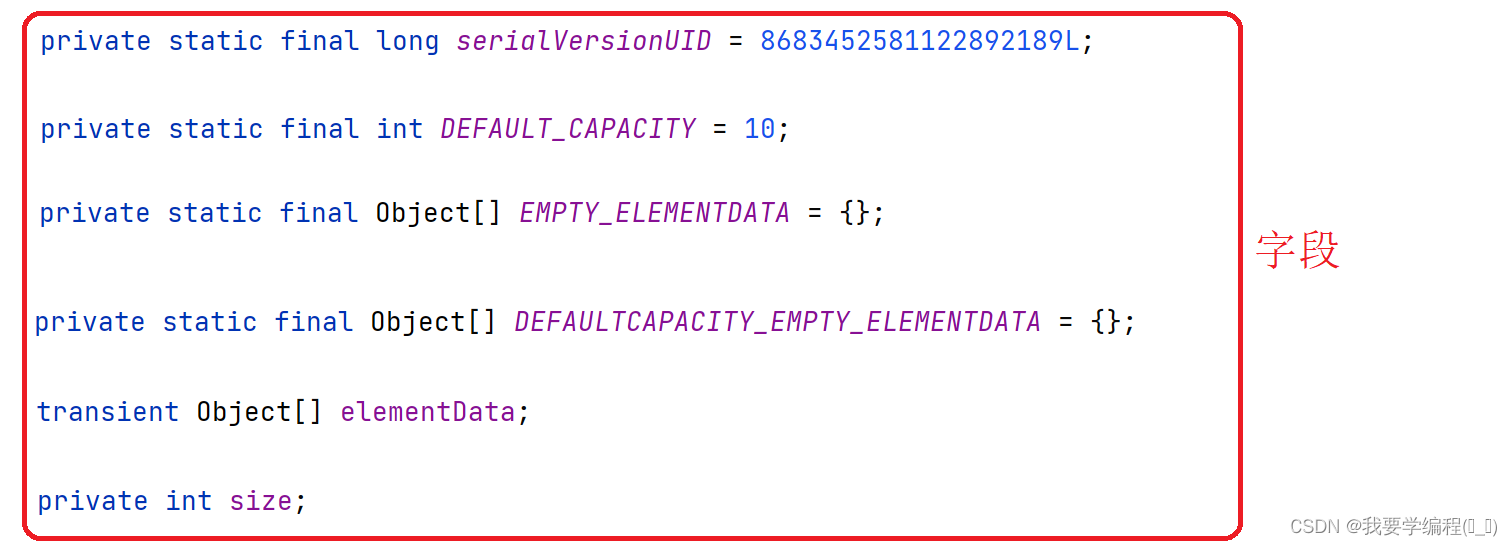
elementData 就是我们自己实现的 elem 数组。
size 就是 usedSize ,也就是这个数组的有效元素的个数。
构造方法:
Java 8 实现的顺序表有三个构造方法。
带有一个 int 类型的参数的构造方法:
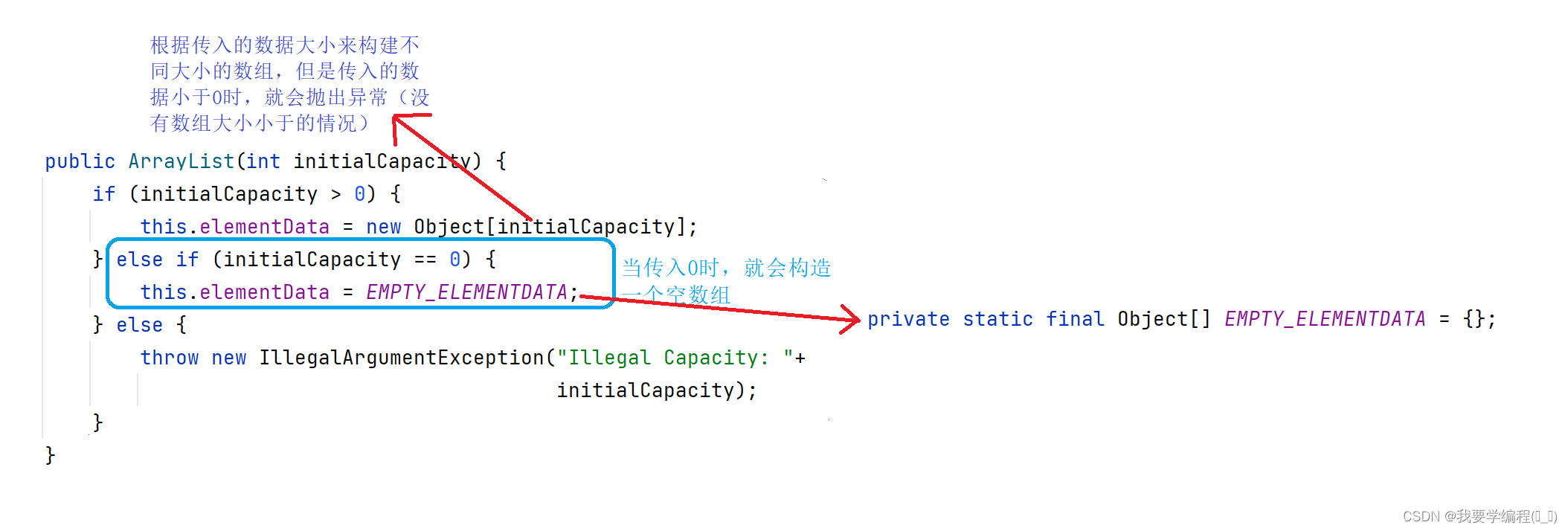
不带参数的构造方法:

带一个 Collection 类型的参数的构造方法:
下面的是其源码:

首先,我们得知道Collection 到底是这个啥?
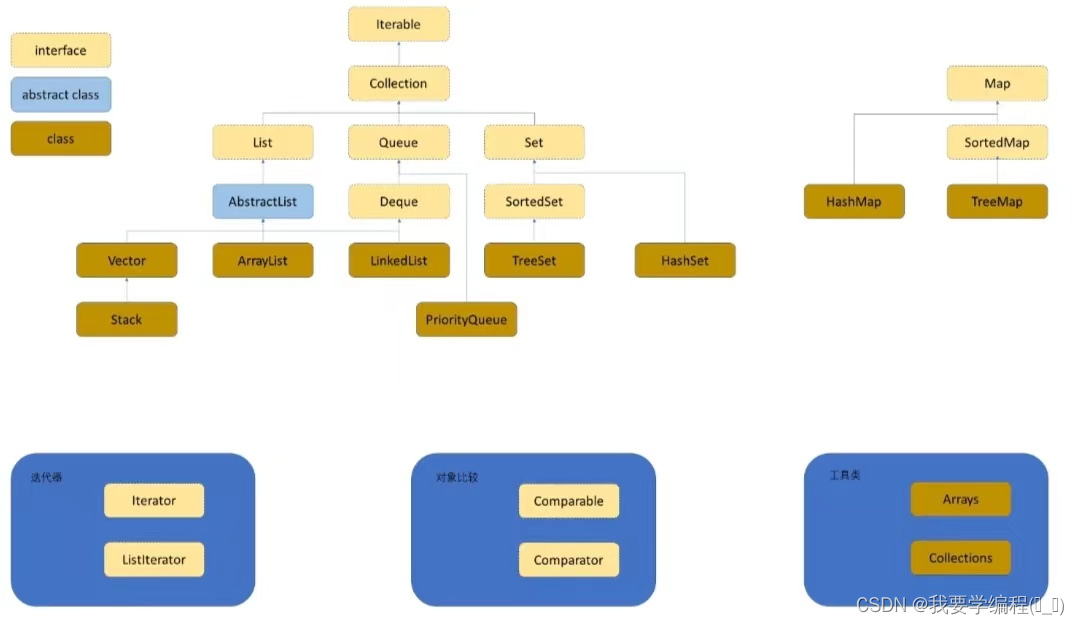
根据上面这个图可以得知:Collection 是一个接口。
上面的参数先不看泛型,那就是Collection c 这个意味着只要实现了Collection 接口,就可以被当成实参传过来。而从上图的关系可知:ArrayList 继承了 AbstractLIst 这个抽象类 ,并且实现了LIst这个接口,而 LIst 这个接口拓展了 Collection 这个接口的功能。也就意味着 ArrayList 这个类实现了 Collection 这个接口。那么 ArrayList 就可以被当成参数传过来。
接下来,就是了解 <? extends E> ,?就可以当成是被传过来的 ArrayList 中的泛型,也就是说被传过来的 ArrayList 中的泛型要是 E 或者 E的子类。例如:

了解了这些,我们就来看源码吧。这个源码的大概意思是把传入的 ArrayList 中的元素给全部拷贝到原来的 ArrayList 的后面。
ArrayList本身的扩容机制和分配内存机制
既然我们在创建一个顺序表的时候,原本是空,那么当我们去增加元素的时候,扩容的机制又是如何呢?
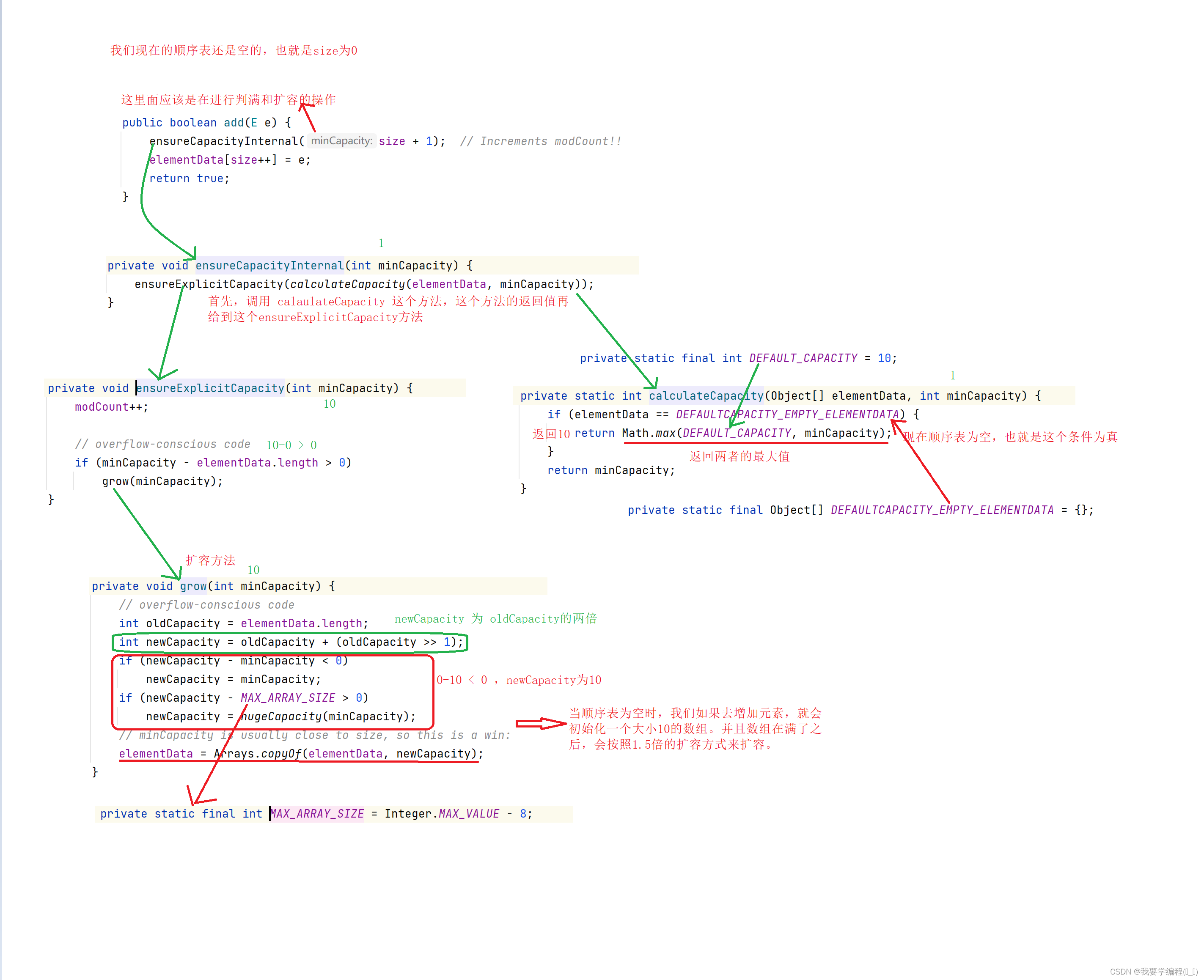
上面是分析过程(可忽略),总之,得出了下面这个结论:
当顺序表为空时,我们如果去增加元素,就会初始化一个大小10的数组。并且数组在满了之后,会按照1.5倍的扩容方式来扩容。如果用户所需大小超过预估1.5倍大小,则按照用户所需大小扩容。
ArrayList常见操作
| boolean add(E e) | 尾插e |
| void add(int index, E element) | 将 e 插入到 index 位置 |
| boolean addAll(Collection<? extends E> c) | 将c 中的元素进行尾插 |
| E remove(int index) | 删除 index 位置元素 |
| boolean remove(Object o) | 删除遇到的第一个o |
| E get(int index) | 获取下标index位置元素 |
| E set(int index, E element) | 将下标 index 位置元素改为 element |
| void clear() | 清空 |
| boolean contains(Object o) | 判断是否在顺序表中 |
| int indexOf(Object o) | 返回第一个o所在下标 |
| int lastlndexOf(Object o) | 返回最后一个o的下标 |
| List<E> subList(int fromlndex, int tolndex) | 截取部分list |
大部分方法,我们都很熟悉。因此这里只展示 addAll()方法 和 subList 方法。
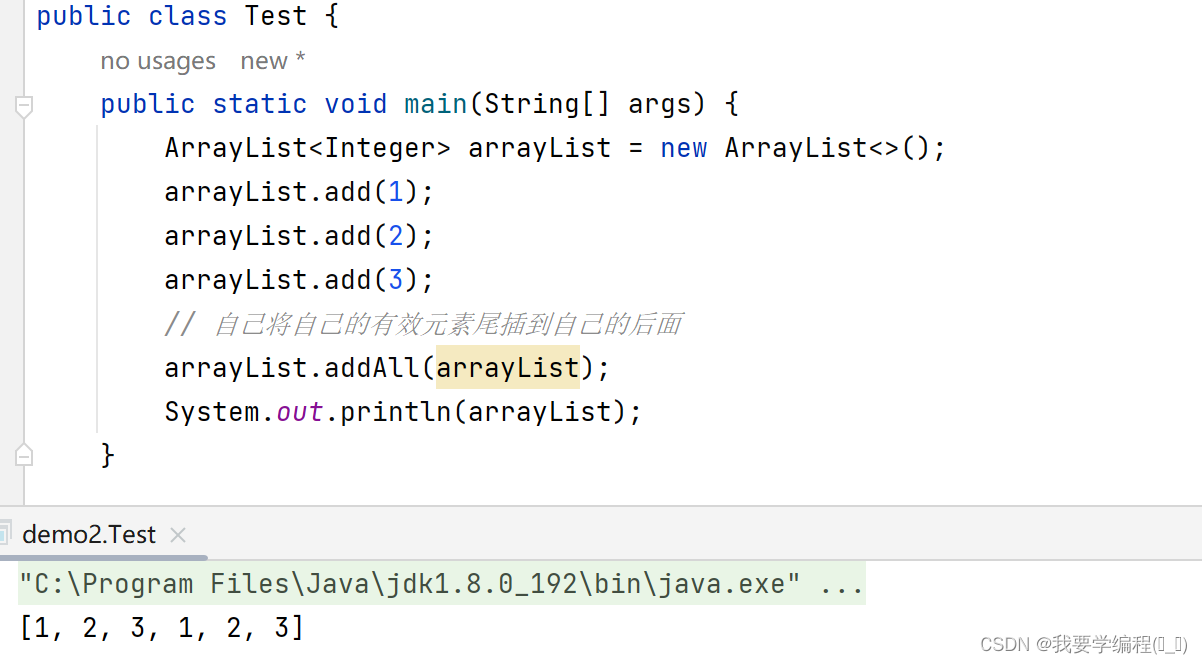
addAll () 方法可以实现 ArrayList 的带Collection 类型的参数的构造方法。
从上面打印的结果可以看出来,ArrayList 是重写了toString 方法的。
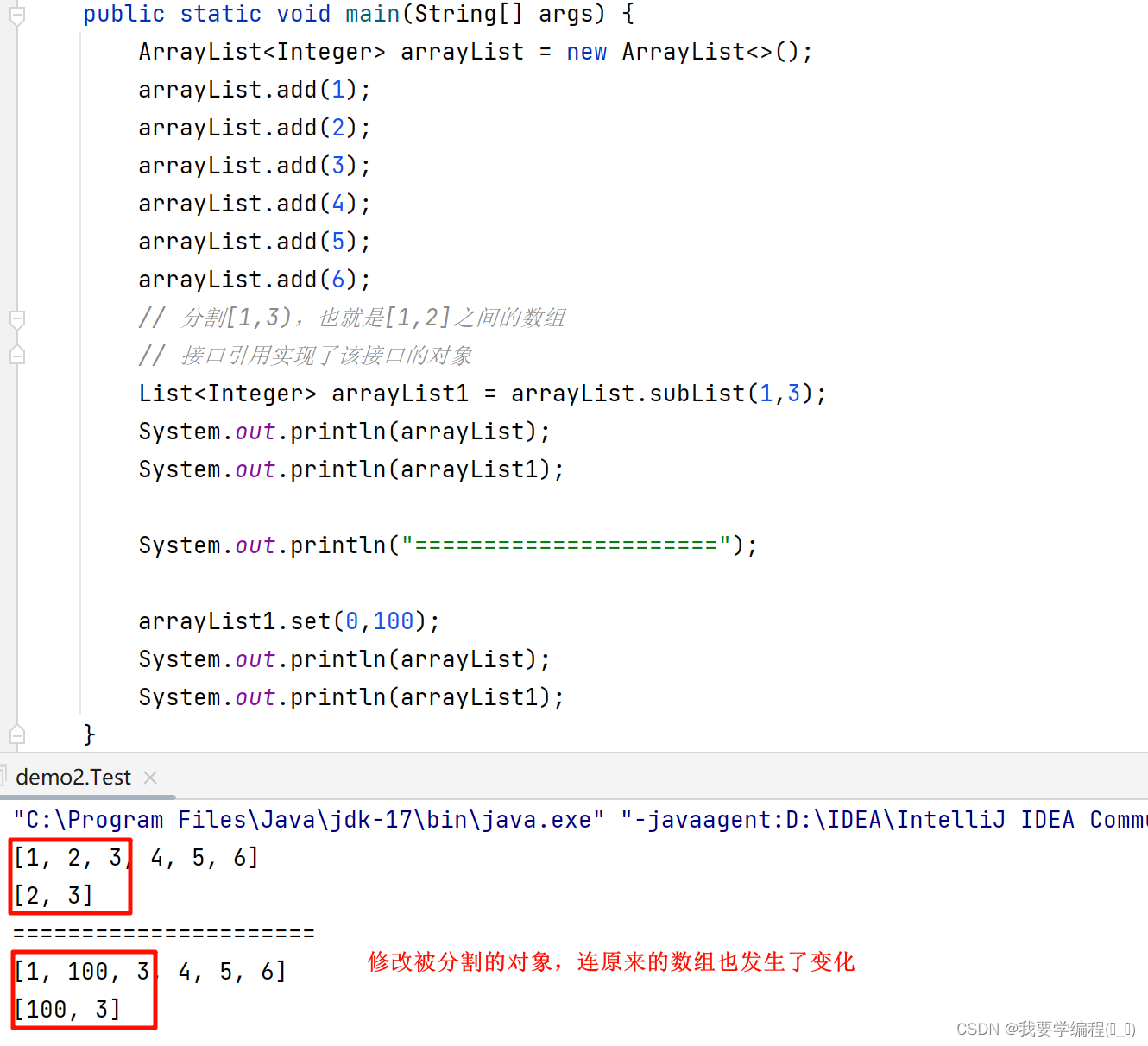
从这里我们就可以看出来,被分割的数组应该是下面这样:

ArrayList的遍历
普通for循环遍历
public class Test {public static void main(String[] args) {ArrayList<Integer> arrayList = new ArrayList<>();arrayList.add(1);arrayList.add(2);arrayList.add(3);for (int i = 0; i < arrayList.size(); i++) {System.out.print(arrayList.get(i)+" ");}}
}for-each遍历
public class Test {public static void main(String[] args) {ArrayList<Integer> arrayList = new ArrayList<>();arrayList.add(1);arrayList.add(2);arrayList.add(3);for (Integer x : arrayList) {System.out.print(x+" ");}}
}toString方法遍历
public class Test {public static void main(String[] args) {ArrayList<Integer> arrayList = new ArrayList<>();arrayList.add(1);arrayList.add(2);arrayList.add(3);System.out.println(arrayList.toString());}
}迭代器遍历
public class Test {public static void main(String[] args) {ArrayList<Integer> arrayList = new ArrayList<>();arrayList.add(1);arrayList.add(2);arrayList.add(3);// 调用iterator方法生成一个迭代器,用Iterator<E>来接收Iterator<Integer> integerIterator = arrayList.iterator();// 如果下一个元素有值话,就进入while循环,并且打印下一个值,最后自己往后走while (integerIterator.hasNext()) {System.out.print(integerIterator.next()+" ");}}
}只要是实现了 Iterator 接口就可以使用迭代器的方式来遍历。就是下面这张图:

好啦!本期 数据结构之ArrayList与顺序表(上)的学习就到此结束啦!我们下一期再一起学习吧!
